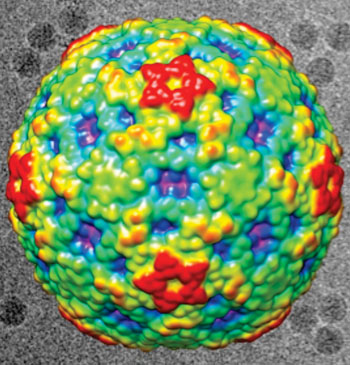Study Suggests Pleconaril Has Potential to Treat EV-D68 Infection
By LabMedica International staff writers
Posted on 12 Jan 2015
The antiviral drug pleconaril effectively blocks the spread of laboratory strains of EV-D68 virus but fails to protect against the strains currently causing an outbreak of childhood respiratory disease in the United States.Posted on 12 Jan 2015
Enterovirus D68 (EV-D68) is a member of Picornaviridae and was the causative agent of more than 1,149 cases of respiratory illness reported among children in the United States in August 2014.

Image: Color-coded image shows the surface view of enterovirus D68, which has stricken children with serious respiratory infections and might be associated with polio-like symptoms. Red regions are the highest peaks, and the lowest portions are blue. In the black-and-white background are actual electron microscopy images of the EV-D68 virus (Photo courtesy of Purdue University).
Investigators at Purdue University (West Lafayette, IN, USA) used advanced X-ray crystallography techniques to study the interaction between EV-D68 and the antiviral drug pleconaril. Pleconaril was developed in the 1990s but has not been approved by the [US] Food and Drug Administration primarily because of a side effect that puts women using birth control drugs at risk of conception.
Results published in the January 2, 2015, issue of the journal Science revealed that the hydrophobic drug-binding pocket in viral protein 1 contained density that was consistent with a fatty acid of about 10 carbon atoms. This density could be displaced by pleconaril. Further experiments showed that pleconaril inhibited EV-D68 at a half-maximal effective concentration of 430 nanomolar and might, therefore, be a possible drug candidate to alleviate EV-D68 outbreaks.
"The compound and the normal pocket factor compete with each other for binding into the pocket," said senior author Dr. Michael G. Rossmann, professor of biological sciences at Purdue University. "They are both hydrophobic, and they both like to get away from water by going into the pocket. But which of these is going to win depends on the pocket itself, the pocket factor, and properties of the antiviral compound."
Although pleconaril was found to be inactive against current strains of EV-D68, it was active against the original 1962 isolate. "Designing the best possible compound for these newer strains will take more time, but I hope that in a year or so we might have something," said Dr. Rossmann.
Related Links:
Purdue University













